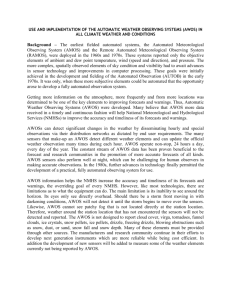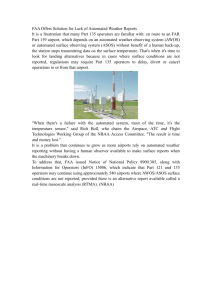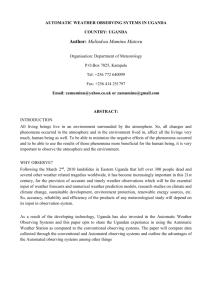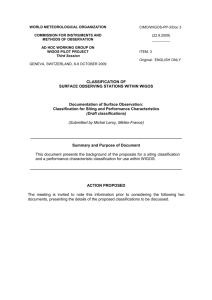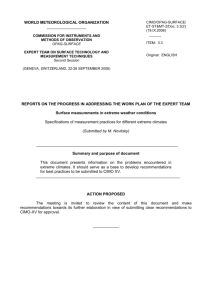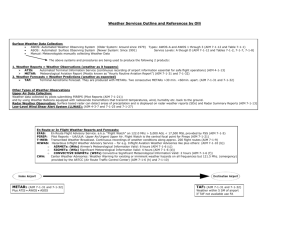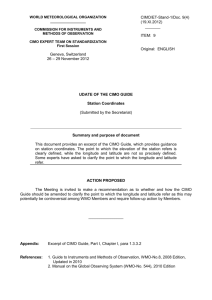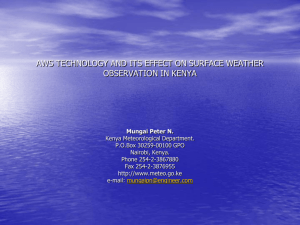2(00)_dombrowsky
advertisement
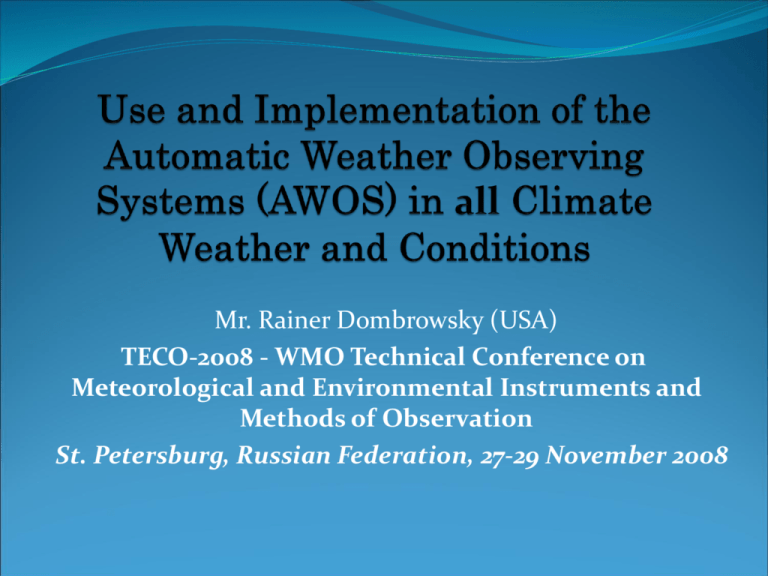
Mr. Rainer Dombrowsky (USA) TECO-2008 - WMO Technical Conference on Meteorological and Environmental Instruments and Methods of Observation St. Petersburg, Russian Federation, 27-29 November 2008 AWS Background The earliest fielded automated systems, the Automated Meteorological Observing System (AMOS) and the Remote Automated Meteorological Observing System (RAMOS), were deployed in the 1960s and 1970s. These systems reported only the objective elements of ambient and dew point temperature, wind (speed and direction), and pressure. More complex, spatially observed elements of sky condition and visibility had to await advances in sensor technology and improvements in computer processing. These goals were initially achieved in the development and fielding of the Automated Observation (AUTOB) in the early 1970s. It was only, when these more subjective elements could be automated that the opportunity arose to develop a fully automated observation system. 2 Background (Cont) AWOS information helps the NMHS increase the accuracy and timeliness of its forecasts and warnings, the overriding goal of every NMHS. AWOSs can detect significant changes in the weather by disseminating hourly and special observations via their distribution networks as dictated by end user requirements. Getting more information on the atmosphere, more frequently and from more locations was determined to be one of the key elements to improving forecasts and warnings. Thus, AWOS were developed. Detailed information and training on AWS can be found in the CIMO IMOP Series [IOM 87 (TD 1307)] at http://www.wmo.int/pages/prog/www/IMOP/publicationsIOM-series.html 3 AWOS ISSUES Automatic observing systems have many diverse user requirements: Operational vs. Research Short vs. Long-term Stakeholder interviews are a common method used in requirements analysis. Temporal and spatial considerations System siting considerations Metadata Cost System performance in various climate regimes Level of data quality 4 PURPOSES BEHIND AWOS Purpose - Automatic weather stations are used for increasing the number and reliability of surface observations. They do this by: Increasing the density of an existing network by providing data from new sites and from sites which are difficult to access and are inhospitable; Supplying, for manned stations, data outside the normal working hours; Increasing the reliability of the measurements by using sophisticated technology and modern, digital measurement techniques; Ensuring homogeneity of networks by standardizing the measuring techniques; Satisfying new observational needs and requirements; Reducing human errors; Lowering operational costs by reducing the number of observers; Measuring and reporting with high frequency or continuously. 5 AWOS IMPLEMENTATION ISSUES Stakeholder Identification - It is increasingly recognized that stakeholders have diverse uses for similar variables. Stakeholder Interviews - communicating with customers and users to determine their requirements. Platform Selection - determining effectiveness requirements, How efficient must the system be to meet its objectives? Platform Performance - requirements which impose constraints on the design or implementation, such as performance requirements, quality standards, or design constraints. 6 AWOS IMPLEMENTATION Platform Site Selection and Installation - Determining the best locations to install AWOSs is the first and the most important step for over-all success in establishing an AWOS network. types of meteorological parameters to be measured; requirements for obtaining identified parameters; variability of parameters surrounding the station; size of the area represented by the station; suitability of the site for conducting meteorological observations; infrastructure and communication facilities, and documentation of all relevant metadata. 7 AWOS IMPLEMENTATION Platform Maintenance - The most important process after the installation of an AWOS network is the implementation of a routine maintenance process including the system and each sub component. An effective maintenance process requires three distinct levels of maintenance as listed below: Protective maintenance Corrective maintenance Calibration 8 AWOS IMPLEMENTATION Protective maintenance - is an equipment maintenance strategy based on replacing or overhauling an item at a fixed interval, regardless of its condition at the time. Protective or preventive maintenance, has to be distinguished from corrective maintenance or condition based maintenance, the process of performing regularly scheduled maintenance tasks. Such routine maintenance can often be performed without locking out a machine. Corrective maintenance - is any maintenance activity which is required to correct a failure that has occurred or is in the process of occurring. This activity may consist of repair, restoration or replacement of components. 9 AWOS IMPLEMENTATION Calibration - The process of determining the performance parameters of an, instrument, or system by comparing it with measurement standards. Adjustment may be a part of a calibration, but not necessarily. A calibration assures that a device or system will produce results which meet or exceed some defined criteria with a specified degree of confidence. Two important measurement concepts related to calibration are precision and accuracy. Precision refers to the minimum discernible change in the parameter being measured, while accuracy refers to the actual amount of error that exists in a calibration. 10 AWOS IMPLEMENTATION Metadata - Users of meteorological observations often need to know the actual exposure, type and condition of the equipment and its operation; and perhaps the methods employed in the taking of the observations. Metadata is particularly significant in the study of climate, in which detailed station histories have to be examined. Metadata should be kept concerning all station establishment and maintenance activities and concerning changes which occur, including calibration and maintenance history, to include changes in exposure and staff if the AWOS is augmented. Metadata are especially important for elements that are particularly sensitive to exposure, such as precipitation, wind and temperature. One very basic form of metadata is information on the existence, availability and quality of meteorological data and of the metadata related to them. 11 Measurements Taken in Harsh Climates Most instruments are designed for use in moderate climate zones, although requirements are intended to be valid for all climate zones. In 2006 the Expert Team on Surface Technology and Measurement Techniques (ET-ST&MT) reported that special attention needed to be give to system operations in harsh environments such a the Arctic, Tropics, Deserts and Mountainious regions as well as climates suseptible to severe weather events. The expert team noted the lack of standardization practices for measurements in harsh climates. It recognized that instrument performance suitable for such harsh cold environments is often attributable to instrument design and not related to the icing condition. 12 Measurements Taken in Harsh Climates At this time only limited guidance material is available on the implementation and maintenance of automatic observing systems which reside in harsh climates. In their report to CIMO the ET identified actions necessary to address these issues: Expansion of the definitions and requirements on measurements in severe/harsh weather conditions. To develop and provide requirements for instrument development addressing the issues related to instrument operation in harsh climates. Encourage instrument manufacturers to develop hardened instruments to meet the challenges related to measurements conducted in harsh climate conditions. Once new instruments are developed organize further evaluation through the intercomparison process. 13 Source: Eumetnet Severe Weather Sensors Project no. 2 14 CIMO ACTIVITIES AND ACTIONS CIMO has addressed the issue of surface measurements in extreme weather conditions with particular focus to icing phenomena, wind and precipitation in cold climates. In extreme climate conditions, reliability of the electronics, data transfers and electricity supply are as critical as the reliability of the sensors themselves. CIMO will closely collaborate with COST on this topic and welcomes a joint WMO/COST publication of the COST 727 Report as an IOM Report. These results will serve further development of guidelines on icing to be published in the CIMO Guide. 15 CIMO ACTIVITIES AND ACTIONS Update of the CIMO Guide table on Operational Uncertainty Requirements and Instrument Performance; prepared and submitted for CIMO XV approval. Regularly used for the preparation of tenders and bids. It is recognized that the existence of an interoperability standard would be advantageous to both users and manufacturers. CIMO and HMEI have agreed in principle to collaborate in investigating the need and interest of manufacturers to work on the development of such an interoperability standard. 16 CIMO ACTIVITIES AND ACTIONS CIMO is developing guidelines and procedures for the transition from manual to Automatic Weather Stations. Guidelines are to be published as an IOM report, since present available training material is out-dated. Guidelines are being considered for their later publication as an annex to the AWS Chapter of the CIMO Guide In addition CIMO has reviewed a proposal for the siting classification of automatic weather stations providing a characterization of the area surrounding the station. Such a classification will provide a sound basis for the development of guidelines for the Siting classification of Surface Observing Stations (not only for AWS). 17 Benefits of AWOS An AWOS network is capable of: collecting, processing and displaying meteorological data; performing automated generation and transmission of meteorological reports; being configured to support a wide range of sensor configurations; supporting a number of data communication options; managing all communication protocols for the various sensors and other associated data communication equipment; storing all relevant data for immediate or future retrieval as required; allowing manual input of additional information unable of being automatically measured; providing the first level of quality control on both data measurement and message generation, and allowing authorized users to access data remotely; 18 Advantages of AWOS Standardization of network observations, both in time and quality; Real-time continuous measuring of parameters on a 24/7 basis; Greater accuracy; Generally more reliable; Conducts automatic data archiving; Provides higher data resolution; Collection of data in a greater volume; Adjustable sampling interval for different parameters; Generally free of reading errors; Generally free from subjectivity; Automatic QC applied during collection and reporting stages; Automatic message generation and transmission; Monitoring of meteorological data; Access to archived data locally or remotely, and Data collection in harsh climates. 19 Disadvantages of AWOS Limited area representation, an area of about 3-5 km around the sensor site; It is not possible to observe all parameters automatically as are done through a manual approach toward taking an observation or an approach whereby the automatic observation is augmented by a human observer, for example cloud coverage and cloud types; More intense ongoing periodic routine maintenance; Increased periodic testing and calibration; Insure that a staff of well trained technicians and specialists is maintained; Insure that a well trained staff of operators is maintained, and Resulting higher cost of instrumentation and operation. However, efficiencies gained through greater levels of automation may result in some cost benefits. 20 CONCLUSIONS Automation of observing systems is being adopted by many more NMHSs with the intent of providing for better meteorological services. An automated weather observing network should be designed with careful attention to user requirements and siting criteria. Products and services expected from AWOS networks should be defined very clearly and should reflect user needs. The proposed network should be flexible enough to absorb new hardware and software components as technology changes. Site selection should be done by following the WMO/ISO recommendations, but infrastructure needs must also be adequately addressed, such as power requirements, grounding, lightning protection, access to the station, as well as considering communication options. 21
